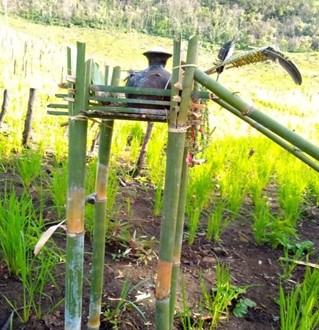Karen Environmental Stewardship of Natural Resources
Main Article Content
Abstract
In northern Thailand, state-driven discourse has often labeled diverse highland minority groups or “hill tribes” as destroyers of the forest, associated with the drug trade, and as non-indigenous migrants. The reality is far more complex. Indigenous groups such as the Karen practice sophisticated traditional ways of environmental stewardship. Specific sites and portions of community lands are set aside and protected from resource usage, including watershed forests, cemetery forests, and forests of spiritual protection where community members’ umbilical cords are ritually deposited. A series of complex and variable taboos regulate hunting activity, including bans on killing certain animals, restrictions and practices that limit waste and overuse. Portions of the landscape that are used for agriculture or resource extraction are carefully stewarded through a cyclical process of asking permission for the temporary use of the land, asking forgiveness for any misuse that may intentionally or unintentionally occur, and offering thanksgiving before ending the stewardship and returning the land to its true non-human owners. These three axes of Karen stewardship – permission, atonement and thanksgiving – comprise a “green circular cycle” that mediates reciprocal relations between human communities and non-human beings, spirits, and the land.
Article Details
References
Boonchai, Kritsada and Pornpana Kuaycharoen. 2014. Karen’s Shifting Cultivation Study: Project for Proposal as Intangible Cultural Heritage. Bangkok: Ministry of Culture, Subcommittee on Shifting Cultivation Studies for Proposal as Intangible Cultural Heritage.
Buergin, R. 2002. “Change and identity in Pwo Karen communities in Thung Yai Naresuan Wildlife Sanctuary, a ‘global heritage’ in Western Thailand.” In Socio-Economics of Forest Use in the Tropics (SEFUT ) 11. http://www.sefut.uni-freiburg.de/
Chiumkanokchai, C. 2008. “Drawing boundary and realigning identity: The Karen in Northern Thailand in the context of tourism.” MSc thesis, Lund University.
Flanagan, B. 2019. “Conservation against conservation: Contesting ways of understanding forests in Southern Myanmar.” MA thesis, University of Hawai’i.
Georgiadis, P. 2022. “Ethnobotanical knowledge against the combined biodiversity, poverty and climate crisis: A case study from a Karen community in Northern Thailand.” Plants People Planet, 4, 4: 382–391. https://doi.org/10.1002/ppp3.10259
Greene, A. M. 2021. “Speaking with an upside-down tongue: Reflections on human-elephant multispecies culture in Northern Thailand.” Gajah, 53: 4–19.
Hill Tribe Research Institute. 2002. Report: The Impact of Modernity on Ethnic Cultures in Northern Thailand [in Thai].
Junsongduang, A., H. Balslev, A. Inta, A. Jampeetong, and P. Wangpakapattanawong. 2013. “Karen and Lawa medicinal plant use: Uniformity or ethnic divergence?” Journal of Ethnopharmacology, 151, 1: 517–527. https://doi.org/10.1016/j.jep.2013.11.009
Kanjanaphan, Anan and Mingsan Kaosa-ard. 1995. Evolution of arable land reclamation in the forest: a case study in the upper northern region. Bangkok: Thailand Development Research Institute.
Maniratanavongsiri, C. 1999. “People and protected areas: Impact and resistance among the Pgak’nyau (Karen) in Thailand.” Doctoral thesis, University of Toronto.
Moo, S. S. B., G. Z. L Froese, and T. N. E. Gray. 2018. “First structured camera-trap surveys in Karen State, Myanmar, reveal high diversity of globally threatened mammals.” Oryx, 52, 3: 537–543. https://doi.org/10.1017/S0030605316001113
Northern Farmers Group Network. 2017. Database of Karen Communities in Thailand. Report for Princess Maha Chakri Sirindhorn Anthropology Centre [in Thai].
Omori, K., L. P. Greksa, P. Chomngandu, S. Noimoung, and S. Sila. 1999. “Morbidity and mortality patterns, health beliefs, and health risk factors of Karen highlanders of northwest Thailand.” Southeast Asian Journal of Tropical Medicine and Public Health, 30, 4: 789–803.
Paul, A. 2018. “’With the Salween Peace Park, we can survive as a nation’: Karen environmental relations and the politics of an indigenous conservation initiative.” MA thesis, York University, Toronto. https://yorkspace.library.yorku.ca/xmlui/bitstream/handle/10315/35877/Paul_Andrew_L_2018_Masters.pdf?sequence=2&isAllowed=y
Paul, A., R. Roth, and S. S. Moo. 2021. “Relational ontology and more-than-human agency in Indigenous Karen conservation practice.” Pacific Conservation Biology, 27, 4: 1–15.
Phatthanaphraiwan, S., L. Zeitler and B. Fairfield. 2022. “The Pagoda of the Gods: A case for Indigenous Karen sacred sites as Special Cultural Zones along Thailand’s borders.” Forest and Society, 6, 2: 1–22.
Platz, R. 2003. “Buddhism and Christianity in competition? Religious and ethnic identity in Karen communities of Northern Thailand.” Journal of Southeast Asian Studies, 94, 3: 473–490. https://doi.org/10.1017/S0022463403000432
Panichkul, Paisit et al. 2017. “The rights of the Karen community (Pga K’nyaw) and the implementation of a special cultural area of swidden cultivation in the strategic area for resolving disputes in the case of arable land and housing of the Karen community in the northern forest area.” Bangkok: Office of the National Human Rights Commission of Thailand.
Pomoim, Nirunrut, Yongyut Trisurat, Alice C. Hughes, and Richard T. Corlett. 2022. “Can Thailand Protect 30% of Its Land Area for Biodiversity, and Will This Be Enough?” Diversity, 14, 5. https://doi.org/10.3390/d14050344
Rajah, A. 1989. “Commensalism as practical symbol and symbolic practice among the Sgaw Karen of Northern Thailand.” Southeast Asian Journal of Social Science, 17, 1: 70–87.
Ribó, I., S. Samachitloed, P. Noopan, C. Satrakom, and P. Kotchamit. 2021. “Kox Kwai Kauv Kox Kwai : Ecopoetic symbolisation in Pgaz K’nyau oral poetry.” Journal of Ethnology and Folkloristics, 15, 1. https://doi.org/10.2478/jef-2021-0007
Santasombat, Y. 2004. “Karen cultural capital and the political economy of symbolic power.” Asian Ethnicity, 5, 1: 105–120. https://doi.org/10.1080/1463136032000168925
Steenhuisen, B. 2020. “Karen perceptions of the forest.” MSc thesis, Wageningen University.
Walker, A. 2003. “The ‘Karen Consensus’, ethnic politics and resource-use legitimacy in Northern Thailand.” Asian Ethnicity, 2, 2: 145–162. https://doi.org/10.1080/14631360124782
Yamamoto, K. 1991. “Religion and religious change in a hill Karen community of Northwestern Chiang Mai province.” Journal of the Siam Society, 79, 2: 124–137. http://www.siamese-heritage.org/jsspdf/1991/JSS_079_2k_Kumiko_ReligionInHillKarenCommunityChiangMai.pdf


